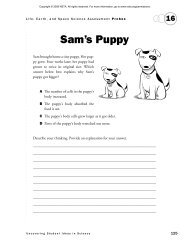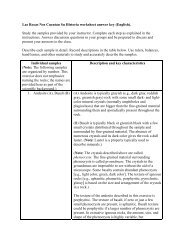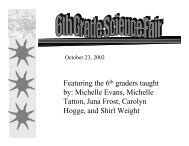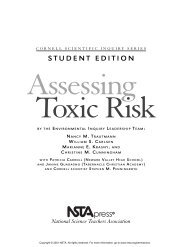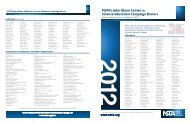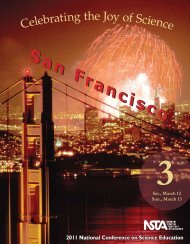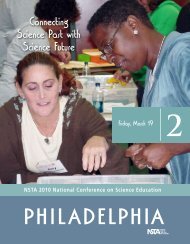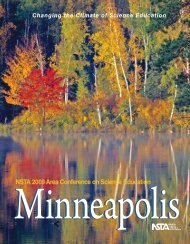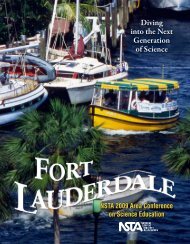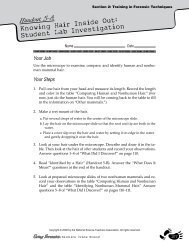New Orleans Program, Vol. 1 - National Science Teachers Association
New Orleans Program, Vol. 1 - National Science Teachers Association
New Orleans Program, Vol. 1 - National Science Teachers Association
You also want an ePaper? Increase the reach of your titles
YUMPU automatically turns print PDFs into web optimized ePapers that Google loves.
Thursday, 3:30–5:00 PM<br />
246<br />
Explore the Next Generation of Instructional Technology on Biology.com<br />
—<strong>Science</strong> Teaching— (Bio)<br />
(Grades 9–12) Room 221, Convention Center<br />
Sponsor: Pearson<br />
Susan Cory, Pearson, Houston, Tex.<br />
Join Pearson presenter Susan Cory as she explores the dynamic digital component of the<br />
Miller and Levine Biology collection—Biology.com. This robust digital support includes a<br />
wealth of assets, such as complete online student and teacher’s editions with audio and editable<br />
worksheets, interactive multimedia, and games. It also includes online assessments with<br />
remediation, a sophisticated classroom management system that offers a seamless transition<br />
from the textbook.<br />
Your Class Can Save Wildlife Around the World! —<strong>Science</strong> Content— (Bio)<br />
(Grades 4–12) Room 224, Convention Center<br />
Sponsor: SeaWorld/Busch Gardens<br />
Sheila Voss, SeaWorld/Busch Gardens, Orlando, Fla.<br />
Julie Scardina, Sea World/Busch Gardens, San Diego, Calif.<br />
With global wildlife crises everywhere we turn, it’s common to feel both overwhelmed and<br />
underequipped. Where do wildlife products come from? Ivory, tortoise shell, and furs look<br />
and feel wonderful—but wildlife pays a big toll. Fishing practices, farming wild animals,<br />
and hunting—what’s right, what’s not? How can any of us make a real difference that actually<br />
helps protect animals, people, and places close to home and around the world? With<br />
the help of a few unforgettable animal ambassadors, some expertly designed teaching tools,<br />
and some real-world conservation success stories, we’ll help you tackle tough subjects with<br />
your students in an engaging, challenging, and inspiring way.<br />
Human Health and Global Environmental Change —<strong>Science</strong> Content— (Env)<br />
(Grades 9–College) Room 225, Convention Center<br />
Sponsor: Center for Health and the Global Environment, Harvard Medical School<br />
Margaret Thomsen (margaret_thomsen@hms.harvard.edu) and Emily Huhn (emily_huhn@<br />
hms.harvard.edu), Center for Health and the Global Environment, Harvard Medical School,<br />
Boston, Mass.<br />
The top-rated Harvard Medical School course Human Health and Global Environmental<br />
Change has highlighted the human health connection to environmental change issues such<br />
as global warming, biodiversity, and land degradation. This session will outline the ways<br />
that these materials can be suited to the secondary education classroom. Free curriculum<br />
available on-site.<br />
Interactive Technology = Interactive <strong>Science</strong> (Gen)<br />
(Grades 5–College) Room 226, Convention Center<br />
Sponsor: Luidia, Inc.<br />
Kathryn Hunt (kathryn@luidia.com), Luidia, Inc., San Carlos, Calif.<br />
Interactive whiteboards integrated with document cameras provide an ideal method for making<br />
all areas of science come alive. Students can review classroom activities with authentic<br />
artifacts captured during class and teachers can build and share professional resources.<br />
Come see sample projects and methods using portable and cost-effective products from<br />
Luidia’s eBeam line.



